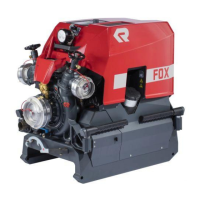Safety
20 / 97
Warning notes
Serious injury to persons and damage due to water hammer effect!
If water delivery via a pipe or hose is interrupted abruptly, a pressure impact
known as the water hammer effect occurs; this is noticeable as a harsh
noise (like a hammer hitting a pipe). This water hammer can cause severe
injury when handling fire-fighting equipment, as well as damage to lines,
hoses, pumps, valves or other pieces of equipment.
Perform adjustments of nozzles, hydrants, valves etc. slowly.
Before opening a discharge outlet, keep a tight hold on the tips and
nozzles.
Before uncoupling a hose, relieve the pressure.
In case of danger for persons (e.g. due to a burst hose) immediately
reduce the pump speed or close the affected discharge outlet. Switch
off the pump system if needed.
Danger to life from electric shock!
Water, fire fighting foam and metallic components conduct electricity.
Do not point turrets or nozzles (extinguishing agent jet) directly at high-
voltage lines or other electrical installations.
Observe the safety distance from voltage-carrying parts at all times.
Foam ban for firefighting involving electrical systems.
Do not handle or use metal ladders near high-voltage lines or other
electrical installations.
Safety distance with C/HP-nozzle for fire fighting on low-voltage systems
Voltage Extinguishing sys-
tem
Extinguishing agent Safety distance
up to 1 kV C-nozzle Water spray jet, dry powder,
extinguishing gas
1 m (3 ft)
C-nozzle Full water jet 5 m (16 ft)
HP- nozzle Full water jet 5 m (16 ft)
Safety distance with C/HP-nozzle for fire fighting on high-voltage systems
Voltage Extinguishing sys-
tem
Extinguishing agent Safety distance
1 kV - 380 kV C-nozzle Water spray jet, dry powder,
extinguishing gas
5 m (16 ft)
C-nozzle Full water jet 10 m (32 ft)
HP-nozzle Full water jet 10 m (32 ft)
Water turret Full water jet 30 m (98 ft)
Water spray jet 10 m (32 ft)

